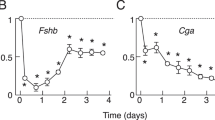Abstract
Lactotroph secretory activity is regulated by hypothalamic stimulating and inhibiting factors as well as peripheral endocrine hormones. In addition to this important control domain, the pituitary gland displays an intrinsic regulatory ability through autocrine and paracrine signals. To evaluate the role of gonadotrophs in the regulation of prolactin (PRL) secretion, a comparative study was performed applying two regulatory agents that operate through different physiological mechanisms: gonadotropin-releasing hormone (GnRH), which releases regulatory factors co-localized in secretory granules of gonadotrophs, stimulating PRL secretion from lactotrophs; and angiotensin II (AII), with direct effects on lactotroph secretion through specific receptors. In these studies performed in regular and purified primary pituitary cell cultures from female rats, the lactotrophs comprised the largest population of cells (about 51%), whereas gonadotrophs represented only a small fraction (3%) of the total pituitary cell count. In regular cell cultures treatments with AII and GnRH showed a similar secretory behavior, increasing PRL output 73% and 63%, respectively. The stimulation with GnRH and AII of cell cultures with purified lactotrophs and gonadotrophs provided comparable results, but the response of lactotrophs was significantly higher (106% and 138%, respectively) than that recorded in regular cell cultures. Simultaneous AII treatment with an antipeptide antagonist to AII receptor (AII-antipep) completely blocked the PRL release induced by AII. The co-incubation of cells with GnRH and AII-antipep suppressed the peak of PRL release caused by GnRH, confirming that AII is a paracrine agent released by gonadotrophs stimulated with GnRH. The different secretory behavior of lactotrophs treated with AII and GnRH in both regular and purified cell cultures is indicative of the degree of functional interactions between different pituitary cell types. The present study supplies morphological and functional information on the cell-to-cell interactions, which plays an important role in the intrinsic regulatory control of PRL secretion.
Similar content being viewed by others
Author information
Authors and Affiliations
Additional information
Received: September 18, 2000 / Accepted: November 22, 2000
Rights and permissions
About this article
Cite this article
De Paul, A., Bonaterra, M., Aoki, A. et al. Cellular and functional interactions between gonadotrophs and lactotrophs in pituitary cell cultures. Med Electron Microsc 33, 231–240 (2000). https://doi.org/10.1007/s007950000023
Issue Date:
DOI: https://doi.org/10.1007/s007950000023




